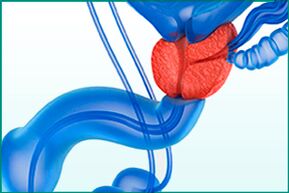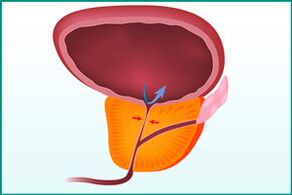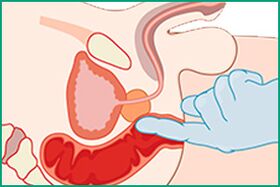Prostatitis is a common urinary tract disease that can occur in any man over the age of 30, and each year its likelihood of developing it only increases. This disease causes serious problems in men: acute prostatitis leads to depression, decreased sex drive and generally disorder of the genitourinary system; Chronic condition causing urinary problems, infertility, impotence.
general information
Prostatitis is an inflammatory condition of the prostate gland, an organ that only men have. Iron made three The most important functions:
The most important functions:
- secretory - produces a special enzyme that regulates the viscosity of sperm and ensures the viability of male germ cells for successful fertilization of the egg;
- motor - controls the muscular tissue of the urethral sphincter, thanks to which the correct course of urine flow occurs, and the secretion of the prostate gland is released during ejaculation;
- barrier - prevents the entry of infectious agents into the upper urinary tract from the urethra, provides an antibacterial barrier, as part of the male immune system.
With prostatitis, the prostate gland enlarges and begins to compress the urethra, disrupting the normal drainage of urine. This organ itself, due to inflammation, cannot perform all of its functions.
The reasons
The source of men's health problems - prostatitis - can develop for the following reasons:
- The presence of congestion in the pelvic region. Usually, such blood stasis occurs due to a sedentary lifestyle, immobility and being overweight.
- Prostate infection. It can go down (through urine) or up (through the urethra), entering the prostate gland with blood or lymph.

The development of prostatitis most often occurs on the basis of the presence of certain risk factors:
- lack of physical activity;
- maintain a sedentary lifestyle;
- irregular sex life;
- hypothermia, especially covering the small pelvis;
- the presence of trauma in the pelvic region;
- weakened immunity;
- malnutrition with a lot of sweet, fatty and fried foods;
- the presence of bad habits;
- infected with sexually transmitted diseases.
Types
According to the ICD-10 (International Classification of Diseases), 4 types of prostatitis are distinguished:
- Acute prostatitis.
- Chronic bacterial prostatitis.
- Chronic prostatitis is non-bacterial, non-inflammatory, and non-inflammatory.
- Chronic prostatitis, asymptomatic.
In the acute form of the disease, the symptoms are strong and clear, the inflammatory process develops rapidly. The most common cause is an infection of the prostate gland with infectious agents that enter from the urethra or blood.
Chronic bacterial form - acute prostatitis, which is not cured in time. The development of the pathological condition is facilitated by the same factors that affect acute inflammation - infection of the genitourinary system and blood stasis in the pelvic organs.
Chronic nonbacterial prostatitis (also called chronic pelvic pain syndrome) is most commonly seen in older men. It can develop against a decline in prostate function and due to an autoimmune response of the body.
Asymptomatic chronic prostatitis is an inflammation of the prostate gland, the patient does not show any discomfort.
Clinic
The clinical picture of acute prostatitis has very vivid manifestations that cannot be ignored and are difficult to live with:
- an increase in body temperature above 38 ° C;
- chills with sweating and weakness;
- severe pain in the lower abdomen, perineum, genitals;
- urinary disorders - dysuria, dysuria, acute urinary retention.
With chronic prostatitis, similar, but less obvious symptoms occur that are often overlooked:
- dull pain in the perineum and lower abdomen, radiating to the sacrum and genitals;
- difficult, painful, and rapid urination with urgent (sharp and irresistible) urges, most often at night;
- erectile dysfunction;
- reduced quality and duration of intercourse;
- reduce the severity of orgasm.
The asymptomatic course of prostatitis took place without complaints from the patient. The problem was discovered incidentally during prostate and/or urine tests.
Diagnostic method
If prostatitis is suspected, the doctor will make a diagnosis, the first step being to clarify the complaints and study the medical history. Information is collected about all symptoms and their development. The following operations are followed:

- Palpate the prostate gland rectally to determine its size, density, and tenderness. For further analysis of bacteria during exploration, gland secrets were also collected. The purpose of the study was to rule out certain diagnoses: adenomas or prostate cancer, rectal cancer.
- Ultrasound and TRUS to supplement and clarify data obtained during palpation.
- Microbiological analysis of prostatic secretions to detect infection and determine the type of pathogen. Data are needed for antibiotic selection and prescribing.
- Blood test to determine the level of PSA (prostate-specific antigen) - allows you to rule out adenomas and adenocarcinomas.
- Biopsy - examining a sample of prostate tissue under a microscope to confirm or rule out adenomas and cancer.
The treatment
Modern urology considers three types of treatment for acute prostatitis and exacerbations of the chronic form of the disease:
- medicine;
- surgery;
- physical therapy.
Drug exposure involves taking antibiotics from the penicillins, fluoroquinolones, macrolides, tetracyclines, cephalosporins, or aminoglycosides. Specific medications are prescribed by your doctor, depending on which infectious agent is causing the inflammation. In addition, the patient is prescribed:
- anti-inflammatory drugs to eliminate fever;
- analgesic;
- antispasmodics to normalize the outflow of urine;
- alpha blockers to relieve symptoms and restore healthy urination.
In the absence of medication or in advanced cases of acute prostatitis, the doctor may prescribe surgical intervention, in which the whole or part of the prostate gland is removed. This surgery is necessary for patients with concomitant problems: stones in the prostate or tumors of a benign and malignant nature.
Physiotherapy is an adjunct to drug therapy, it is carried out only after the acute inflammatory process has been eliminated. Patients are shown:
- Massage;
- therapeutic exercise (physical therapy);
- acupuncture therapy;
- ultrasound treatment;
- Electrical stimulation;
- exposure to microwaves and lasers;
- Acupressure.
The appointment of a specific type of procedure is made by the attending physician.

In the case of chronic prostatitis in remission, the patient is required to:
- undergo regular examinations and, if necessary, a course of antibiotics;
- eat in moderation, avoid exhaustion and weight gain;
- protect the body from hypothermia;
- engage in exercise therapy, and exercises should strengthen the muscles of the lower abdomen and pelvic floor;
- have a regular sex life;
- give up bad habits.
Another useful procedure is prostate massage, thanks to which the blood circulation and excretory flow in the organ are improved, and this helps to prevent the recurrence of the acute phase of the disease.
Complications
Complications of prostatitis are manifested in both the prostate itself and its surrounding organs, which are caused by anatomical location. In the acute form, infectious agents can reach the bladder and kidneys, inflammation - go to the fatty tissue of the gland, venous plexus and rectum.
Chronic disease is dangerous because it affects not only the tissues and organs surrounding the prostate gland, but also the neurological, urinary, and reproductive areas.
Possible complications of acute prostatitis:
- abscess;
- phlebitis of the venous plexus in the small pelvis;
- adipose tissue inflammation;
- orchitis;
- epididymitis;
- vesicular inflammation;
- pyelonephritis.
Chronic prostatitis causes the following complications:
- chronic pain syndrome;
- sexual dysfunction;
- dry;
- violation of the process of urination;
- general decline in quality of life.
impotence and sterility
The two most common problems associated with prostatitis are impotence and infertility. The development of each condition occurs against the background of chronic damage to the prostate gland.
Impotence (erectile dysfunction) is manifested in 40% of cases of neglected and untreated prostatitis. The development of complications occurs over a long period of time, sometimes for many years. His reasons:
- violation of the prostate gland with the wrong transmission of nerve impulses and the failure of hormone production;
- impaired control of the pelvic muscles that cause an erection;
- psychological uncertainty;
- pain syndrome, which causes fear of the possibility of failure in bed.
It is impossible to talk about the unconditional link of prostatitis with infertility. The disease has an indirect effect on a man's fertility and with only an advanced chronic phase. Causes of fertility problems against the background of prostate damage:
- reduced quality of semen;
- decreased sperm count and motility;
- the presence of lesions and defects of germ cells;
- vas deferens;
- failure of the excretory function;
- testicular dysfunction.
In acute prostatitis, sperm is damaged, their quality and motility are impaired, defects are formed, and a lower number of male germ cells are produced.
Prevent
Prostatitis can be prevented, but some prevention recommendations need to be constantly followed:
- have a healthy lifestyle with proper nutrition, reasonable physical and sexual activity, no bad habits;
- engage in physiotherapeutic exercises aimed at eliminating blockages in the pelvic organs and strengthening the pelvic muscles;
- promptly undergo examinations by a urologist and gynecologist;
- prevent hypothermia.
Prostatitis is a dangerous disease of the urinary tract, which can cause significant harm to the male body. It is very important to pay attention to the first signs of its appearance and visit specialists who will prescribe adequate treatment. Without this, the acute condition can become chronic and cause even more serious health problems.

























